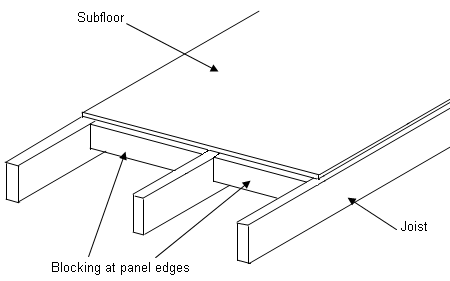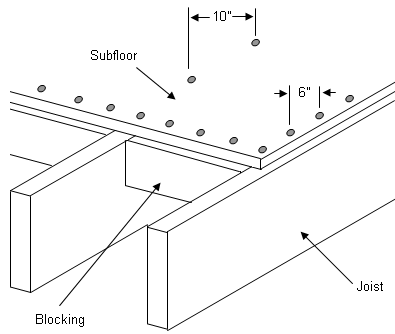Problem: Noise Problems - Floor Squeaks 2
Cause:
Sub-floor movement.
Most subfloor movement takes place at the edges of panels, where they are the weakest. When the edge of a panel between floor joists carries a concentrated load, such as a person walking across the floor, the edge of the panel deflects. This deflection may be small, but if the neighboring panel is not loaded, squeaking may occur because the two panel edges will rub against each other.
Solutions:
Provide backing or blocking at panel edges.
Check all subfloor panels for damage before installation.
- The simplest way to eliminate movement for square edged panels is to install blocking between the joists at all panel edges. Edge blocking is only required by building codes in certain situations. However, in higher traffic areas, it may be worth the time and effort to block all panel edges to eliminate movement between subfloor panels. Blocking must be installed properly to prevent if from becoming a source of squeaks rather than a means of eliminating them as shown in Figure 4.

Figure 4 - Panel Edge Support Using Blocking Between Joists
- While some building codes will require that blocking not be less than 2″ × 2″ (38 × 38 mm), 2″ × 4″ (38 × 89 mm) material provides more structural support for the edges of the subfloor panels. In locations of ducting and other obstacles, the blocking can be installed on the flat. In all cases, the top of the blocking must be flush with the top of the floor joists.
Space panels.
- Leaving a small gap between square edged panels ensures that the deflection between joists due to loading will not result in edges rubbing on each other. The gap also allows for panel expansion, should site conditions cause the panel to swell. Most building codes do not specify spacing between sub-floor panels, but most sub-floor panel manufacturers recommend a spacing of about 1/8″ (3 mm).
Use tongue-and groove panels.
Interlocking the panel edges by using tongue-and-groove subflooring provides a supporting effect similar to that of blocking the panel edges. The loads on one panel are effectively transferred to the adjoining interlocking panel. Movement between panels is virtually eliminated.
- Ensure that the tongue portion of the panel is not damaged, as this can actually create squeaks. Tongue damage can occur if the panels are forced together, but in most cases the damage to the tongue occurs in shipment or in poor handling when the material arrives and is stored on site.
Fasten edges of panels.
- Properly fastening the panel edges can reduce the amount of subfloor movement, especially when the fastening is done in combination with installing tongue-and-groove panels or placing blocking at panel edges. Most building codes require that fasteners be installed at 6″ (150 mm) on center along edges and at 12″ (300 mm) on center along intermediate supports.
- The manufacturers of sub-floor panels recommend the same spacing for panel edges but some recommend 10″ (250 mm) on center along intermediate supports as shown in Figure 5.
Properly fastening the subfloor to floor joists is an area where many diy home handymen and non professional tradesmen do not do a proper job. Attaching the sub-floor to the floor joists is very labor intensive and if you do not have the proper power tools, it takes even longer. The finished floor is only as good as the base, its sub-floor. It is imperative, if you want a quality finished project that the sub-floor be properly fastened to the floor joists.

